 |
| February 21, 2012 | Volume 08 Issue 07 |
Designfax weekly eMagazine
Archives
Partners
Manufacturing Center
Product Spotlight
Modern Applications News
Metalworking Ideas For
Today's Job Shops
Tooling and Production
Strategies for large
metalworking plants
Long-travel piezomotors:
New innovations, new solutions
By Scott Jordan and Stefan Vorndran, PI (Physik Instrumente) L.P.
Abstract
Piezoelectric actuation is the foundation for a myriad of mission-critical, high-technology applications from semiconductor manufacturing to atomic-force microscopy, from optical tweezers to sub-pixel imaging, from battlefield targeting to genomic sequencing and medical devices. Known for nanometer precision, piezoelectric principles are proving highly adaptable to new configurations and modalities. Recently developed mechanisms built on a variety of novel applications of piezoelectric technology have burst through the former travel limitations familiar from classical nanopositioning mechanisms. But like those time-tested mechanisms, solutions built on these newer principles offer high axial force, exceptional speeds, compactness, fieldlessness, and stable position hold without dither. These long-travel piezomotors offer valuable, proven solutions for engineers grappling with tough technical and economic needs.
Introduction
In a variety of fields, cutting-edge applications are placing conflicting demands on structural and motion subassemblies. Increasingly, positions must be controlled in more degrees of freedom with higher dynamic and static accuracy, yet faster throughputs and longer travels are necessary to meet financial metrics. Compactness is prized, yet high speeds are demanded.
These conflicting requirements have, until recently, had no solution. Application examples abound:
- Optic assemblies of escalating sophistication require multiple axes of nanoprecision alignment yet must remain aligned for months of round-the-clock usage.
- Emerging nanoimprint lithographies demand exquisite positioning and trajectory control yet must retain alignment integrity under significant physical and thermal stresses.
- Applications ranging from cell-phone cameras to endoscopy and fluid delivery require exceedingly small but stiff and responsive and reliable positioning of optics, probes, shutters, and other small loads.
Fortunately, a confluence of new piezo-based approaches has breathed new capability into the nano- and micro-positioning world. Some of these represent significant incremental advancement of essentially traditional mechanisms; others represent significant forks in the road of positioning technology.
Nanometer precision over millimeters: Long travel flexures
When precision is needed, piezoelectric actuation is the default choice.
Similarly, when high force or high dynamics is required, piezoelectric actuation represents the gold standard. Piezo actuators have long been used in semiconductor manufacturing and testing applications for their extreme speed and precision. Lately, microscope manufacturers and medical device manufacturers have also warmed up to the benefits of this actuator technology that has even been embraced by the automotive industry.
Traditionally, piezo stack actuators offered limited maximum travel, on the order of 0.1% of the stack's length. Effective flexure-lever amplification approaches have since been devised over many years that now provide travels up to 2 mm. The downside is that the stiffness of lever mechanisms diminishes as the square of the lever ratio. This limits the bandwidth and thus the tracking performance of traditional servo-control techniques. So, demands for longer travels plus faster actuation or higher holding force are at cross-purposes. Furthermore, at some point the granularity of the driving DAC will begin to be seen, limiting coarse positioning resolution or introducing bit-transition noise in position waveforms.
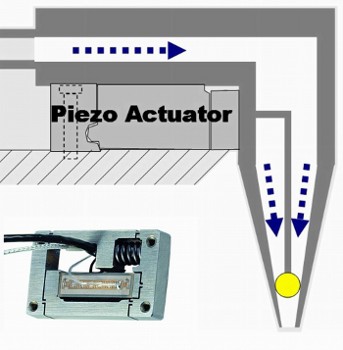
Figure 1: Piezo flexure actuators provide travel ranges from 0.1 mm to 2 mm with high force and speed. They are optimized for microfluidics and nanodosing in biotechnology or medical design and also available for fast autofocus applications. This sketch shows a small, low-cost flexure actuator and the basic design of a precision micro-valve.
This is now addressable by novel control technologies. Digital dynamic linearization, a non-traditional algorithm integrated into the latest digital nanopositioning controls, virtually eliminates following errors in repetitive motion patterns and scanning of these long-travel nanomechanisms.
The controller integrates the algorithm into the metrology and servo logic; this optimizes the internal command generated for a repetitive waveform according to the error signal detected with the internal sensor. A brief (typically <1 sec) auto-optimization is commanded by the user (or a reload of previously saved optimizations) when application changes occur.
After this, following errors are reduced to approximately the noise level of the system. This capability is supported by internal waveform generators and software drivers, including COM objects, DLLs, and LabVIEW libraries.
Eliminating the travel/resolution tradeoff
Piezo actuation is roughly proportional to applied voltage, typically generated by a digital-to-analog converter (DAC) driving an amplifier. The number of addressable positions for a piezo mechanism is 2b – where b is the bit-width of the DAC's digital input. Traditionally, the resolution of the nanopositioner can be no better than its travel divided by this number.
With today's long-travel flexure nanopositioners, achieving tight resolution goals requires higher and higher DAC bitness.
Until recently, a DAC's limitations were permanent characteristics of the specific chip chosen by the designer. Popular PC analog I/O interfaces like those from National Instruments typically top out at 16 bits, providing 65,536 possible output voltage states, with update rates to several million per second and useful waveform and synchronization capabilities, plus compatibility with popular programming languages like C++, VisualBASIC, and LabVIEW. OEM engineers designing their own controls might choose a 20- or 24-bit DAC for their custom circuit design, but care must be taken, as they can present drift issues, noise, or other drawbacks. Sometimes a new design is not economically practical, necessitating use of lower-bitness legacy DACs, potentially problematic when highly leveraged PZT mechanisms are used.
The recently introduced, patented HyperBit technology leverages the under-utilized time-domain capability of today's DACs, converting it into up to 11 additional bits of physical positioning resolution. HyperBit employs modulation of the DAC's least-significant bits (LSBs) to accomplish this. For example, the LSBs can be dithered using pulse-width modulation at a high rate. The result is higher positioning resolution without tradeoffs.
Many mechanisms and devices can benefit; a video which demonstrates this effect using a commonplace panel meter is available here. For ease of implementation, this technology has now been built into the industry's first LabVIEW library for analog nanopositioner interfacing.
Nanometer precision over centimeters
To address applications needing longer travels than can be met via lever amplification of piezo stack actuators, engineers have developed an array of new technologies based on novel configurations and actuation modes of piezo ceramics.
Resonant piezomotors (ultrasonic motors)
In one example of this breed of piezomotors, a ceramic wafer is configured so that high-frequency excitation drives one or more resonant modes in its material, conferring a micron-scale oscillatory motion to a friction pusher tip affixed at an antinode. The pusher tip, oscillating like a miniature pogo-stick with nanoscale amplitudes and frequencies of hundreds of kHz, can then be preloaded against a guided workpiece, driving long-travel motion with dynamical behavior somewhat similar to that of DC servomotors.
A wide assortment of linear- and rotary-motion configurations have been commercialized by providers in many countries over several decades, both open and closed loop. By eliminating lead screws and their inertia and associated linkages and structures, such mechanisms can be very compact and responsive. For example, off-the-shelf linear stages can provide 19 mm of travel at up to 500 mm/sec and 10-g acceleration with a 0.1 mm resolution linear encoder, all in a package 35-mm square.
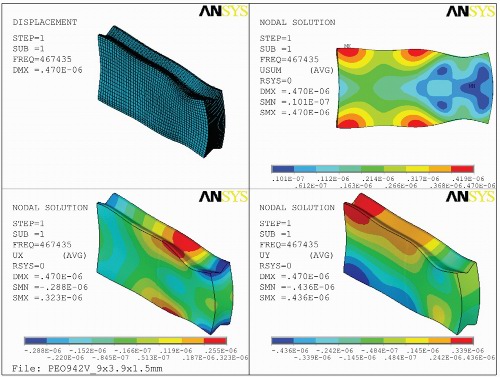
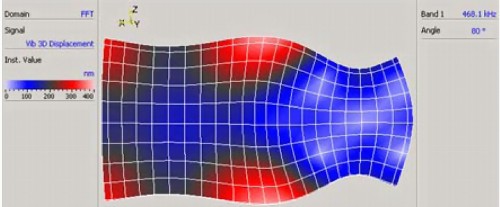
Figures 2a1 (top) and 2a2: Vibrational behavior of a piezo ceramic slab in a miniature ultrasonic motor (measured with 3D scanning laser vibrometer).
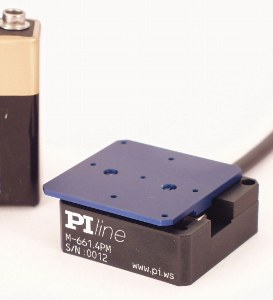
Figure 2b: Miniature translation stage with ultrasonic linear motor compared to a 9-V block battery. This unit provides 0.8 in. of travel with speed to 20 in./sec and 10-g acceleration. A high-resolution linear encoder is also integrated. Smaller versions are feasible.
In-position stability is superior to conventional stages since the actuator acts as a brake when quiescent. Fieldlessness, vacuum compatibility, long life, and other signature advantages of piezo actuation also apply.
The drawback to these piezomotors has traditionally been their difficulty of control. Ideally, any motor would exhibit a linear stimulus-to-velocity curve. A small amount of friction present in most DC-motor mechanisms means a small but non-zero stimulus produces zero velocity – a departure from the desired linearity. Conventional control technologies overcome this stiction with an integrating filter that escalates the stimulus as needed.
Resonant piezomotors have a similar behavior, though from a different cause.
Just as a child on a pogo stick must achieve a certain threshold "bounce" before he moves, a certain threshold of stimulus must be applied to the resonant piezomotor before motion begins. This deadband behavior is great for in-position stability, but conventional P-I-D controls tend to be unhappy with it: so much integrator gain must be applied to accommodate the deadband that the setting is incompatible with running at speed. The controller oscillator frequency also needs to be in tune with the resonant frequency of the ceramic slab in the piezomotor, a fact that in the past required initial tuning and frequent adjustments during operation of a system.
Both problems were solved with the latest generation of ultrasonic motor controllers developed by PI. An auto-tuning circuit constantly keeps the oscillator frequency in the optimum range, and a faster processor now automatically switches between gainsets, enabling the user to take full advantage of high-velocity constancy and the exceptional stability these friction motors provide at rest.
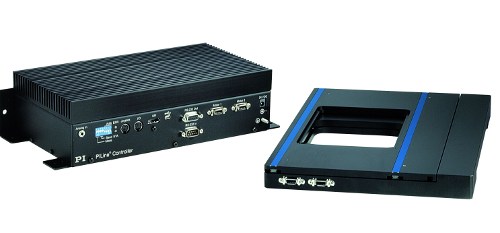
Figure 3a: 2-axis ultrasonic motor controller and a compact XY long-travel microscope stage. The intrinsic autolocking principle of the ultrasonic motor provides excellent long-term stability in microscope applications.
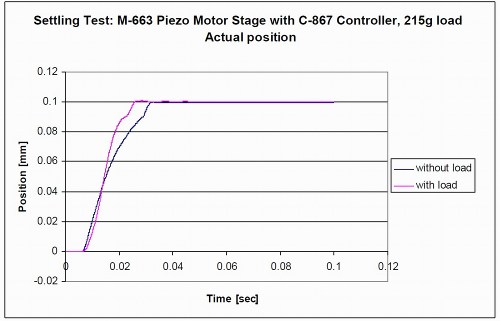
Figure 3b: Settling behavior of an ultrasonic stage shows the extreme accelerations and fast setting this motor/controller combination is capable of.
Piezo walking drives
By combining piezo elements acting in longitudinal and transverse directions, the foundation for a walking actuator is composed. These elements can be compressed against a longitudinal rod to confer motion. One familiar progenitor of this family of mechanisms was the Burleigh Inchworm.
More recently developed mechanisms offer extraordinary stiffness and holding force and are optimized for reliability in applications requiring long-term position hold while providing centimeters of travel with picometer-class resolution.
An even newer solution uses cost-effective bender-type piezo elements. Size and cost are substantially reduced; power-off stiffness is still remarkable, with 10-N holding force. This design also provides centimeters of travel range and picometer-class resolution, ideal for applications like optic positioning in microlithography and sample positioning in electron microscopy.
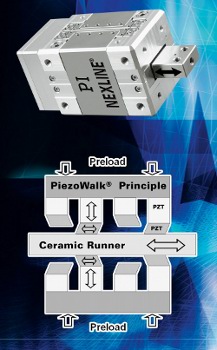
Figure 4a: High-load PiezoWalk linear motor capable of 800-N holding force, shown with operating principle.
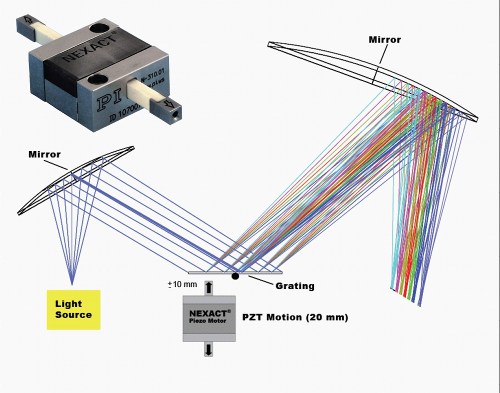
Figure 4b: Optimized for next-generation microlithography alignment and positioning, NEXACTR actuator provides 10-N power-off holding force and smooth coarse/fine motion over centimeters with picometer-class resolution in a compact, cost-effective format.
In the case of both of these mechanisms, motion occurs in two modes: a long-travel stepping mode and a fine-motion analog mode in which the actuator elements are sheared but not stepped, providing sub-nm positioning capability.
Hybrid motorized/piezo mechanisms
While the mechanisms discussed so far can displace magnetic motors, piezo actuation can also be combined with them for coarse/fine motion.
Traditional "stacked" coarse and fine mechanisms operate independently; the piezo mechanism greatly improves the minimal incremental motion capability of the system, but the overall repeatability is no better than the motorized stage alone.
The advent of linear encoders with nm-scale resolution has allowed construction of hybrid mechanisms where both the coarse and fine mechanisms share the same feedback sensor. Coordinated by advanced controls, this hybrid provides piezo-class repeatability and fast dynamics over many cm of travel.
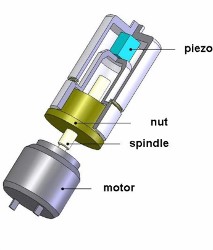
Figure 5a: Hybrid lead screw (spindle)/nut system with piezo fine adjustment for elimination of stick/slip effect and velocity variation. The unit is controlled by a special hybrid dual (PZT/ DC servo) controller, getting its position feedback from one external high-resolution 1-nm-class linear encoder.
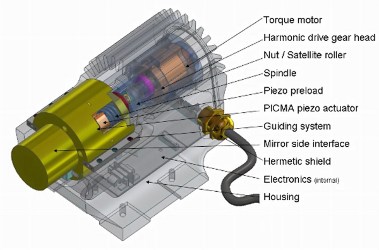
Figure 5b: Custom hybrid piezoelectric and (brushless torque) motor actuator system with 0.6-in. travel and 200-lb force for astronomical application. The system provides extremely accurate positioning and tracing within less than 2-nm RMS.
Conclusion
The field of piezo motion control has expanded rapidly in recent years, with a wealth of new concepts introduced, all aimed at eliminating piezos' former travel limitations while preserving their unmatched resolution, responsiveness, and throughput capabilities.
Consequently, not only is piezo actuation increasingly suitable for applications formerly addressable only by magnetic motors, but significant benefits accrue in terms of size, speed, fieldlessness, reliability, vacuum compatibility, resolution, dynamics, and reliability. These, in turn, are enablers for significant advances in existing and new applications.
About the authors
Scott Jordan is director of NanoAutomation Technologies for PI (Physik
Instrumente) L.P. A physicist by training with an MBA in new venture management and finance, he publishes frequently on nanotech developments, including novel instrumentation, software, and microscopy techniques. Email stefanv@pi-usa.us, www.pi-usa.us
Stefan Vorndran is VP of marketing at PI (Physik Instrumente) L.P. He holds an MS in EE from University of Darmstadt/Dieburg, Germany. He has held several positions in sales, product management, and applications support of piezo technology and precision motion control equipment at Polytec PI, Inc. and at the Physik Instrumente HQ in Germany.
References
1. S. Jordan, S. Chen, M. Culpepper, "Positioning Resolution Enhancement of MEMS and Piezo Nanopositioners," Proceedings of the 4th International Symposium on Nanomanufacturing, pp. 166-170, 2005, Cambridge, MA, USA.
2. P. Pertsch, S. Richter, D. Kopsch, N. Kraemer, J. Pogodzik, E. Hennig, "Reliability of Piezoelectric Multilayer Actuators," ACTUATOR 2006, Bremen, Germany, pp. 527-529.
3. R. Gloess, "Nanometer Precise Hybrid Actuator in Positioning Mechanism with Long Travel Range," ACTUATOR 2006, Bremen, Germany, pp. 668-671. 4. K. Spanner, S. Vorndran, "Advances in Piezo-Nanopositioning Technology," Proceedings of the IEEE/ASME International Conference on Advanced Intelligent Mechatronics, 2003, Kobe, Japan.
5. S. Jordan, H. Marth, "Novel High-Bandwidth Active Parasitic Motion Compensation for Sub-nm Planarity in AFM and Profiler Applications," Proceedings of the ASPE, 2007, Dallas, TX.
Published February 2012
Rate this article
View our terms of use and privacy policy
